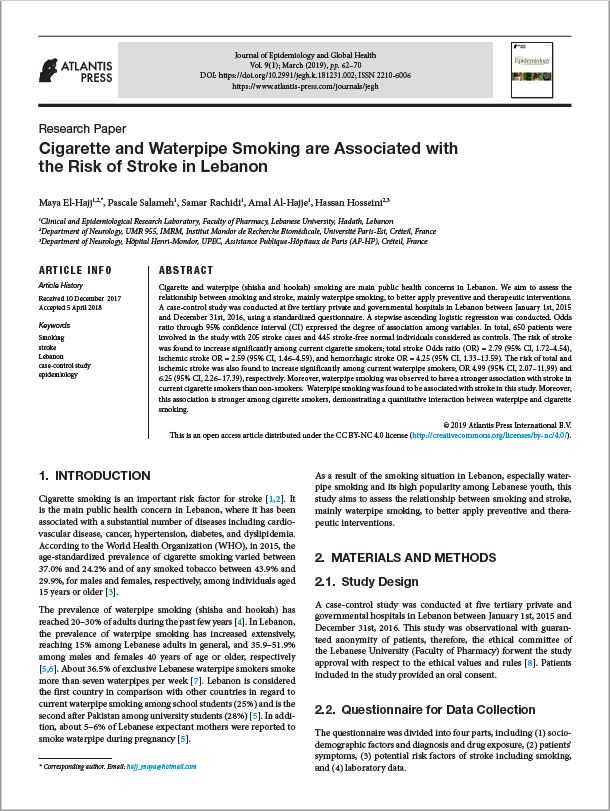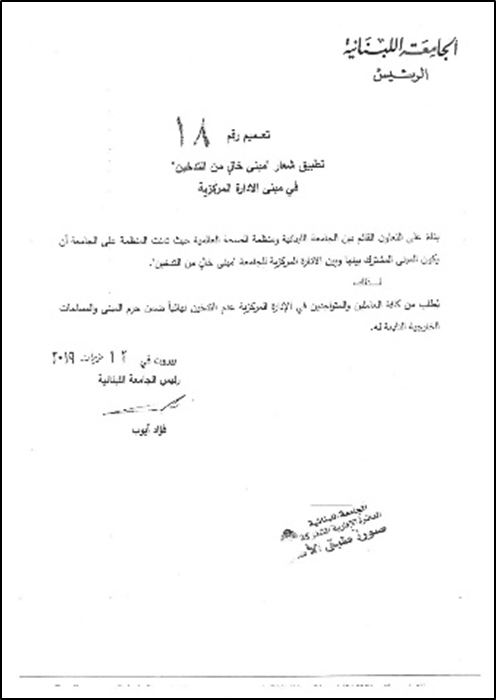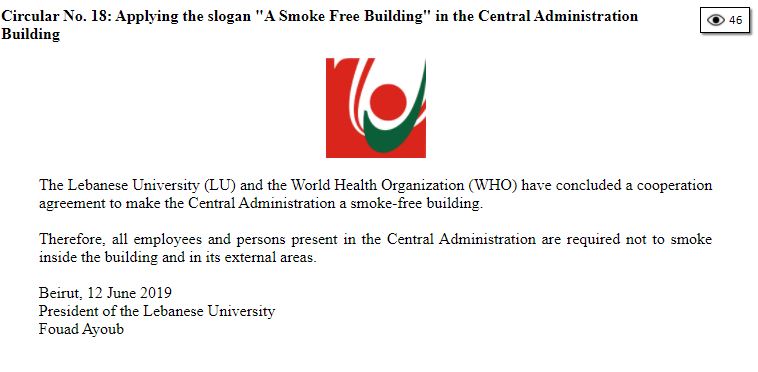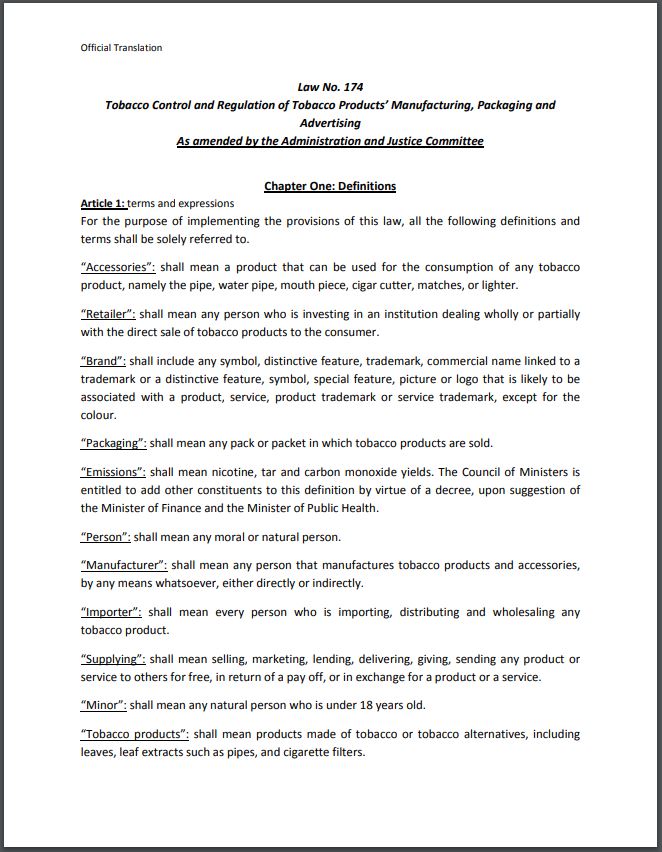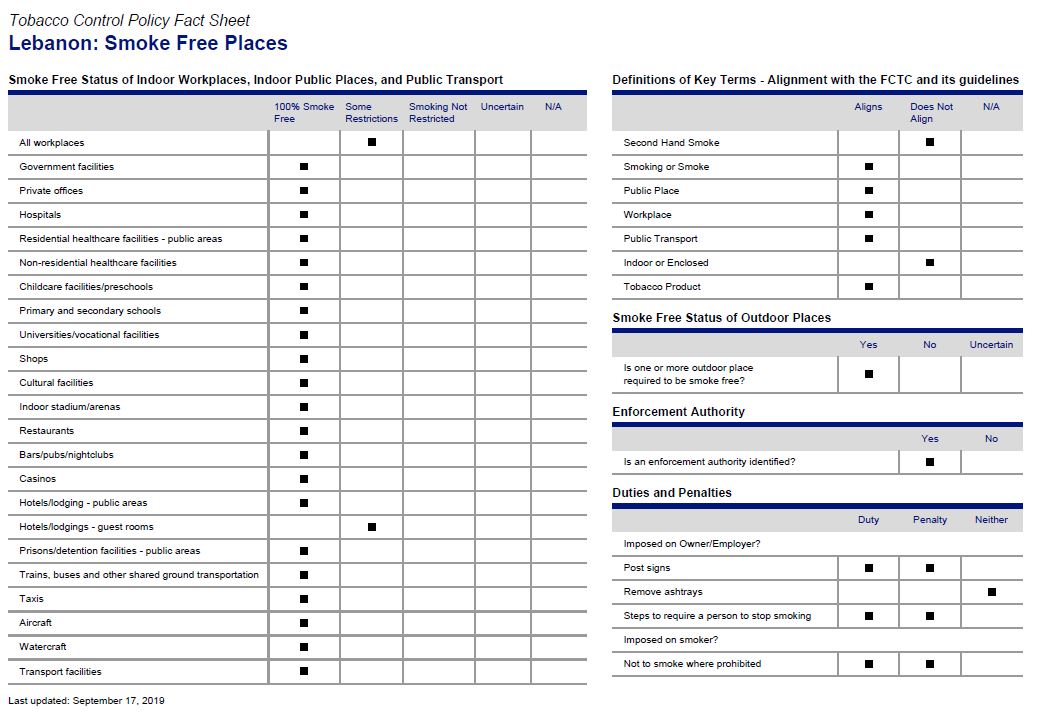3.3.6.University policy 'Smoke-free'
A Smoke Free Building
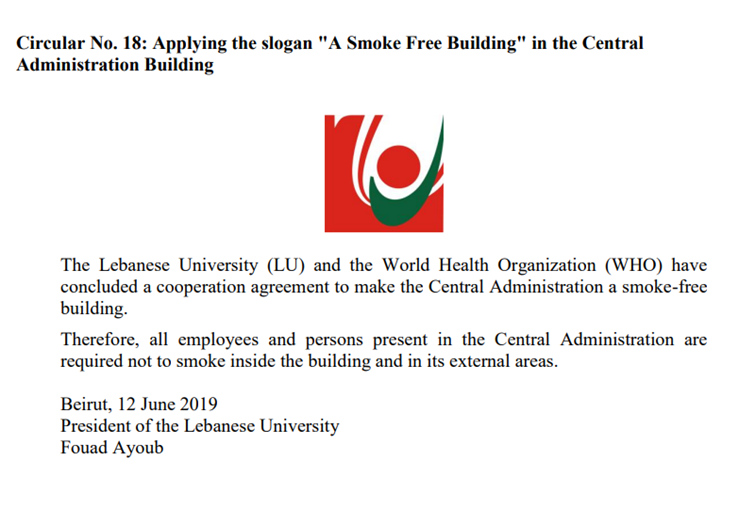
On September 5, 2021, the Journal of Cellular Molecular Medicine published a scientific article by Dr. Marwan Othman (from the Laboratory of Health and Environment Microbiology at the Lebanese University) in which he addressed smoking and its impact on the development of oral candida infection under the title:
Smoking-aggravated oral candidiasis: Nrf2 pathway dampens NLRP3 inflammasome
The study, which was carried out in collaboration with Dr. Nicolas Papon from the University of Angers (L'université d'Angers) in France, focused on smoking and its effect on increasing the susceptibility of the oral mucosa to infection with Candida albicans by activating the Nrf2 pathway, which in turn negatively regulates the inflammatory particle (NLRP3).
It is known that smoking harms the immune system of the oral mucosa, but few studies have focused on the immune imbalance in vivo caused by this bad habit, so the results of this study open new horizons for researchers to delve into the study of (NRF2) as a goal related to smoking-related oral diseases caused by candida of various kinds.
It is noteworthy that the Laboratory of Health and Environment Microbiology of the Faculty of Health and the Higher Institute of Doctorate in Science and Technology - Lebanese University has been interested in the study of medicinal fungi, infectious diseases and antifungal resistance.
Background and Objective: Cardiovascular diseases (CVD) are the leading cause of death globally. Assessing CVD knowledge, attitude, and practice (KAP) is necessary to spread awareness about CVD in Lebanon, their corresponding risk factors, and behaviors in which individuals can avoid or minimize the possibility of developing a CVD.
Subjects and Methods: This was a case-control analytical study that targeted 921 CVD and non-CVD subjects. A questionnaire form was used to collect data related to patients’ demographics, socioeconomic status, habits, medical and family history, KAP towards CVD, and source of information. Data was analyzed using SPSS v.25.
Results: Data from 921 participants were distributed over the CVD group (52.6% males aged 58.3 ± 13.7 years [n = 460]) and the non-CVD group (47.7% males aged 36.3 ± 15.4 years [n = 461]). CVD patients were significantly older than non-CVD subjects (p < 0.001). All three KAP scores of both groups were of poor to fair levels. Both CVD knowledge and attitude mean scores in CVD patients (26.6 ± 5.2 over 40 [66.50%] and 63.3 ± 10.2 over 85 [74.47%], respectively) were significantly higher than the ones of non-CVD subjects (23.5 ± 7.9 over 40 [58.75%] and 61.4 ± 12.4 over 85 [72.74%], respectively, p < 0.001). However, the CVD mean practice score was significantly lower in CVD patients (6.0 ± 1.7 over 9 [66.67%]) than the one of non-CVD subjects (6.3 ± 2.2 over 9 [70.00%] p < 0.001). Mostly, educational level (p < 0.001), governorate (p <0.01), and smoking (p < 0.001) were predictors of KAP CVD in both groups.
Conclusion: With an overall limited knowledge, attitude, and practice toward CVDs, the Lebanese population (with CVD or non-CVD) needs targeted national campaigns about CVD according to the identified predictors of CVD KAP to prevent and to alleviate the complications due to CVDs.
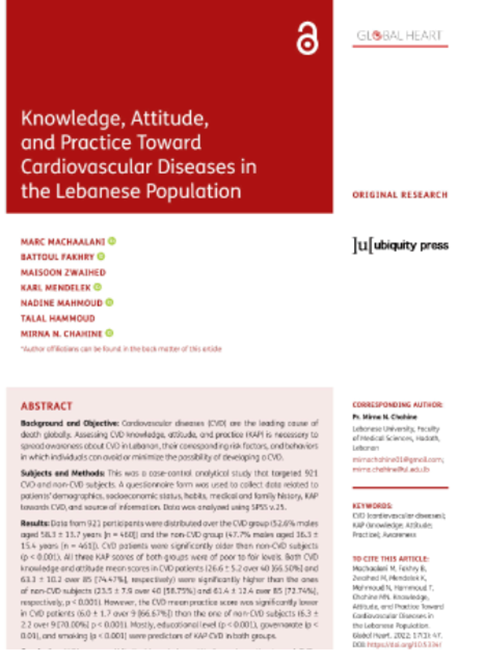
The Lebanese University issued several circulars including Circular No. 18 prohibiting smoking inside the building, pursuant to the Anti-Smoking Law issued by the public authorities and smoking was restricted to open areas and spaces defined for that. The Lebanese moderate weather does not necessitate designated closed areas for smoking.
Circular No. 18 prohibiting smoking
The circular determines that:
The Lebanese University (LU) and the World Health Organization (WHO) have concluded a cooperation agreement to make the Central Administration a smoke-free building.
Therefore, all employees and persons present in the Central Administration are required not to smoke inside the building and in its external areas.
In addition to the Circular that the University has and taking into account that smoking is considered an epidemic and an important threat to public health facing the world, recognizing that tobacco dependence is the main preventable cause of illness and death. For this, some activities have also been developed such as:
With the support of WHO Lebanon and the Ministry of Public Health, “Al Riaya” institution with “Wa Baaden” team launched a project “Toward smoke-free universities” in 12 universities in Saida. The Lebanese University and the University of Saint Joseph were among the participating universities.
Toward smoke-free universities
Tents were set in the participating universities where the team members explained the objectives of the smoke-free competition and provided information to the students on smoking harm. Five universities were declared “smoke-free” at the end of the project.
Similarly, the university is governed by Lebanon's smoke-free law, which determines. Lebanon ratified the FCTC in 2005, but until 2011, tobacco control policies remained rudimentary and not evidence-based. Beginning in 2009, a concerted advocacy campaign was undertaken by a variety of stakeholders with the aim of accelerating the process of adopting a strong tobacco control policy. The campaign was successful, and Law 174 passed the Lebanese Parliament in August 2011.
The passage of tobacco control law 174 in Lebanon: reflections on the problem, policies and politics
Smoke Free Places
Smoking is prohibited in nearly all enclosed public places, enclosed workplaces, and public transport. However, the law allows hotels to designate 20 percent of their room capacity as smoking rooms. Outdoor areas of health, education, and sports facilities must also be smoke-free. In this case, the University must be a smoke-free place.
Smoke Free Places
The following information was taken from:
Tobacco information
Tobacco Advertising, Promotion and Sponsorship
There is a comprehensive ban on tobacco advertising and promotion. There are some restrictions on tobacco sponsorship and the publicity of such sponsorship.
Tobacco Packaging and Labeling
Tobacco product packaging must carry text-only health warnings on 40 percent of the front and back of the package. Rotation is required. Misleading packaging and labeling, including terms such as “light” and “low tar”, is prohibited.
Cigarette Contents and Disclosures
The law does not grant the authority to regulate the contents of cigarettes. The law does not require that manufacturers and importers disclose to government authority’s information on the contents and emissions of their products.
Sales Restrictions
The law prohibits the sale of tobacco products via vending machine and in schools, healthcare facilities, restaurants, nightclubs and enclosed places. The law also prohibits the sale of small packets of cigarettes. The sale of tobacco products is prohibited to persons under the age of 18.
E-Cigarettes
The retail sale of e-cigarettes is prohibited. The use of e-cigarettes is prohibited in places where smoking is prohibited. The law prohibits the advertising and promotion of "tobacco products," which includes e-cigarettes, but permits limited forms of sponsorship.
Roadmap to Tobacco Control Legislation
Law No. 174, Tobacco Control and Regulation of Tobacco Products’ Manufacturing, Packaging and Advertising, regulates smoking in public places, workplaces and public transport; tobacco advertising, promotion and sponsorship; and tobacco packaging and labeling. This law replaces Law No. 394/95 and Ministerial Decision No. 1/213. Smoke free provisions went into effect immediately for all public places, workplaces and public transport, except those for restaurants, nightclubs, hotels, and other tourism venues, which went into effect one year later. The law introduced a comprehensive ban on tobacco advertising, promotion and sponsorship, which entered into force on March 1, 2012. The law increased the size of warning labels to 40 percent. The contents of the text-only health warnings were issued in Decree No. 8991, which was scheduled to enter into force in October 2013, though implementation was delayed. The packaging and labeling provisions of Law No. 174 also entered in force at that time. Decree No. 7437 was issued in January 2012 and established by-laws addressing signs at points of sale. Decree No. 8431 was issued in July 2012 and regulates the posting of "No Smoking" signs in smoke free places.
In the same way, in the Lebanese University research is carried out to analyze the effects of cigarettes on the Lebanese:
The paper: “Smoking social acceptability in Lebanese adults: Effect of age, gender, family influence, and residence”
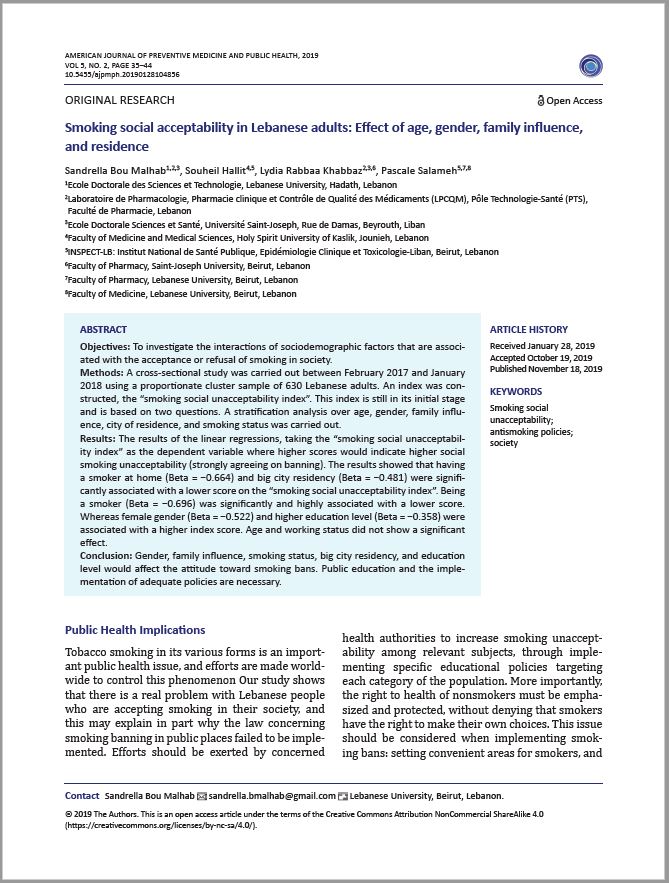
The paper: “Indoor secondhand tobacco smoke emission levels in six Lebanese cities”
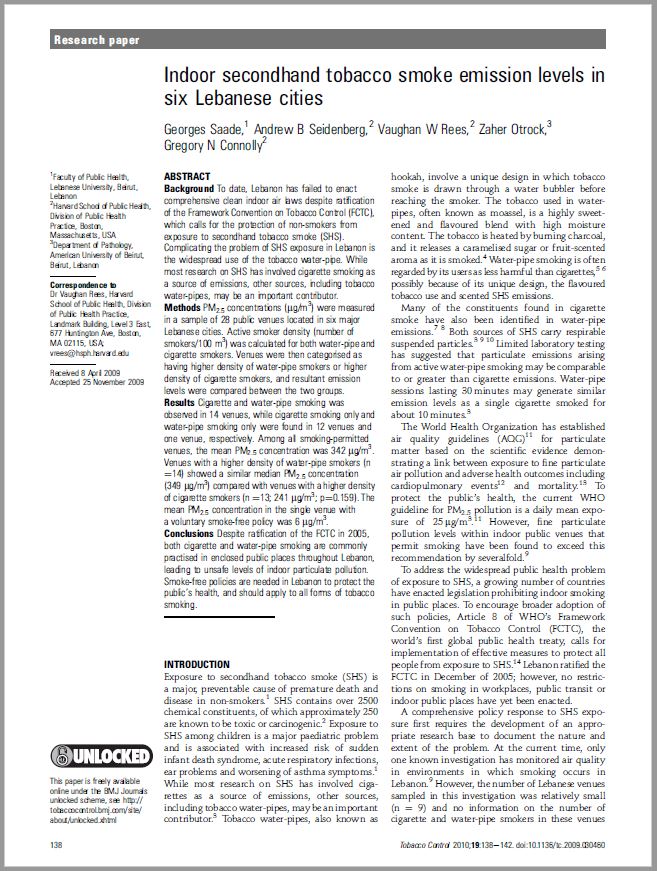
The paper “Support for the smoke-free law: cross sectional study of university students in Lebanon”
Lebanese university students support for smoking ban law
This study explores the level of support of Lebanese university students to the smoke-free law adopted in Lebanon. The first part is a principal component analysis leading to a support score and the second part is an analysis of the results on support and its determinants.
The paper “Cigarette and Waterpipe Smoking are Associated with the Risk of Stroke in Lebanon”
